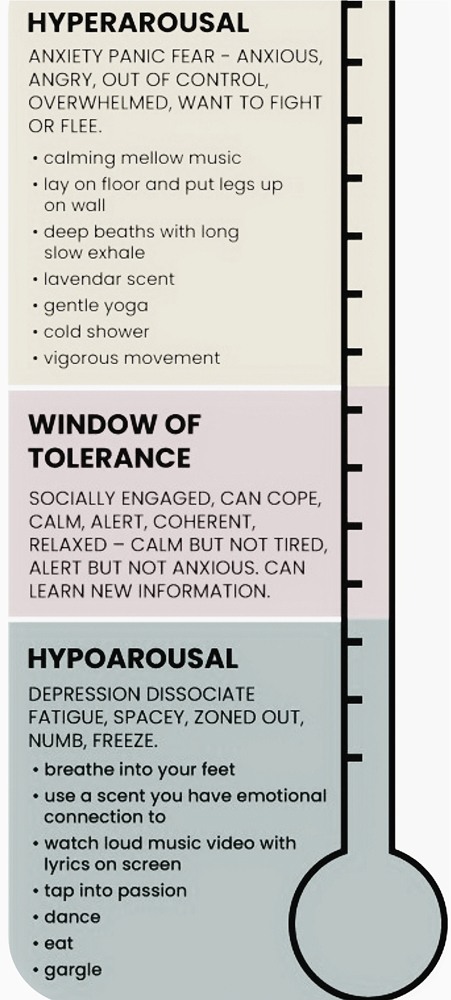Dysregulation & Ways To Create Safety
When our bodies get stuck in fight-or-flight or freeze mode, we can lose our sense of safety in the world and in our body. This can cause our nervous systems to become dysregulated. This lack of safety in our body can lead to increased stress. The video below explains how a dysregulated nervous system creates stress and what you can do to help yourself.
How Can We Create Safety In Our Body?
(This text is to refer to after watching the above video).
In today’s fast-paced world, stress and trauma can take a toll on our nervous systems, affecting our overall well-being. Somatic Experiencing (SE), a therapeutic approach developed by Doctor Peter Levine, offers a range of practices to help build safety within the nervous system. Below are several of Doctor Peter Levine’s practices, with the addition of some new techniques I personally endorse.
Number 1
RESOURCING.
Resourcing is a foundational practice in Somatic Experiencing. It involves identifying and cultivating positive internal resources that help us feel grounded and supported. These resources can include memories of safety, people who provide comfort, or places that evoke a sense of calm. By focusing on these resources during times of stress, we can establish a sense of safety within our nervous system. Practicing gratitude, envisioning safe spaces, or recalling moments of joy are effective ways to activate these resources and create a buffer against overwhelming sensations.
Click HERE for further information
Number 2.
ORIENTING
Orienting is a technique that encourages us to be present in our environment and engage our senses. By tuning into the sights, sounds, and sensations around us, we stimulate the parasympathetic nervous system, promoting relaxation and reducing the “fight or flight” response. This practice helps reestablish a connection with the external world, allowing us to feel more anchored and secure.
Click HERE for further information
Number 3.
BREATHWORK
Conscious breathwork is a powerful tool for regulating the nervous system. Techniques like diaphragmatic breathing activate the vagus nerve, which is responsible for calming the body’s stress response. By focusing on slow, deep breaths, we send signals to the brain that it’s safe to relax. Breathwork can be combined with other practices, such as resourcing and orienting, to enhance their effectiveness.
Click HERE for further information
Number 4.
PHYSIOLOGICAL SIGH
The physiological sigh is a deep inhalation followed by a prolonged exhalation. It helps regulate the nervous system by promoting relaxation and maintaining lung function. It enhances oxygen exchange, and resets the respiratory system, which can aid in reducing stress and maintaining respiratory health.
Click HERE for further information
Number 5.
HAVENING TOUCH
Havening touch, also known as self-soothing touch, involves gentle stroking of the arms, face, and hands. This touch triggers the release of delta wave activity in the brain, promoting relaxation and reducing anxiety. By self-administering Havening touch, we activate the parasympathetic nervous system, fostering a sense of safety and comfort within our own bodies.
Click HERE for further information
Number 6.
STAYING WITHIN THE WINDOW OF TOLERANCE
The concept of staying within the “window of tolerance” is crucial in Somatic body work. It refers to maintaining a balance between the two extremes of the nervous system’s response: hyperarousal (fight or flight) and hypoarousal (freeze or collapse). When we’re within this window, we can respond to stressors adaptively without becoming overwhelmed. The practices mentioned above help us stay within this window by regulating our nervous system’s arousal levels.
Click HERE for further information
Number 7.
GAMUT POINT NERVOUS SYSTEM RESET
This acupuncture point sends a message to your triple warmer meridian to calm down and reduce stress. This meridian is responsible for activating your “fight or flight” response, which can make you feel anxious and tense. But by using the gamut point, you can reset the parasympathetic nervous system, which helps you relax and feel calmer.
Click HERE for further information
Incorporating these body based practices like resourcing, orienting, breathwork, the gamut reset point and Havening touch we can significantly enhance our nervous system’s ability to cope with stress and trauma. By building safety within, we create a resilient foundation that allows us to navigate life’s challenges with greater ease. These practices empower us to stay within the window of tolerance, promoting emotional regulation and overall well-being. Remember that each person’s journey is unique, so it’s important to explore these techniques and find what works best for you. As you engage in these practices, you’ll discover the transformative power of building safety within your nervous system.
Additional Education
“While the seven concepts above are helpful in facilitating the regulation of the nervous system, it is imperative to allocate additional focus onto the ‘window of tolerance.’ This is to provide you with the most comprehensive understanding possible.”
The Window Of Tolerance
The concept of the “window of tolerance” was originally formulated by Dr. Dan Siegel, MD, to depict the ideal range of emotional arousal for an individual to navigate daily life effectively. When a person operates within this range, they can effectively manage and deal with their emotions.
For individuals who have undergone trauma, regulating their emotions can be quite challenging, and their functional window of tolerance tends to become quite limited.
When a person has experienced trauma, maintaining a connection to the present can be especially challenging as the past often looms vividly and intrusively. Such individuals are often on high alert, hyper-vigilant for potential threats, which significantly narrows their window of tolerance.
The stress induced by traumatic memories or triggers may push them beyond their window of tolerance. Even seemingly minor stressors can trigger disassociation, anger, or anxiety in a person, leading to states of heightened or diminished arousal.
The below image depicts clearly the 3 states using the window of tolerance thermometer.
This identifies what is happening within your body, and what you can do to help yourself feel more regulated.
I hope this further clarifies the window of tolerance, enabling you to stay within its bounds.

